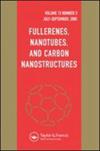Determining the defect type in a graphene lattice
IF 1.8
4区 材料科学
Q3 CHEMISTRY, PHYSICAL
Fullerenes, Nanotubes and Carbon Nanostructures
Pub Date : 2023-11-14
DOI:10.1080/1536383x.2023.2280752
引用次数: 0
Abstract
AbstractWe consider four common defects that appear in an infinite single-layer graphene lattice, i.e. single vacancy V1(5−9), Stone-Wales SW (55−77), and double vacancies V2(5−8−5) and V2(555−777). Investigating the honeycomb pattern of the graphene, we make use of the concept of shortest closed paths (periodic orbits) in the underlying topological structure. Using properties of the shortest closed paths of odd length we present and prove mathematically an algorithm that classifies which one of these defects occurs.Keywords: Grapheneinverse problemsingle vacancy defectdouble vacancy defectStone-WalesMATHEMATICS SUBJECT CLASSIFICATION (2020): 47N6081Q1034A5534B45 Disclosure statementNo potential conflict of interest was reported by the authors.Additional informationFundingThis work was supported by the National Research Foundation of South Africa under grant no.s 89147 and 103530.确定石墨烯晶格中的缺陷类型
摘要本文研究了无限单层石墨烯晶格中出现的四种常见缺陷,即单空位V1(5−9)、Stone-Wales SW(55−77)和双空位V2(5−8−5)和V2(555−777)。为了研究石墨烯的蜂窝状结构,我们利用了底层拓扑结构中最短闭合路径(周期轨道)的概念。利用奇长度最短闭合路径的性质,我们提出并证明了一种算法,该算法可以对这些缺陷中的哪一种进行分类。关键词:石墨烯逆问题单空位缺陷双空位缺陷stone - wales数学学科分类(2020):47N6081Q1034A5534B45披露声明作者未报告潜在利益冲突。本研究由南非国家研究基金会资助,资助号:S 89147和103530。
本文章由计算机程序翻译,如有差异,请以英文原文为准。
求助全文
约1分钟内获得全文
求助全文
来源期刊

Fullerenes, Nanotubes and Carbon Nanostructures
工程技术-材料科学:综合
CiteScore
4.80
自引率
17.40%
发文量
85
审稿时长
1 months
期刊介绍:
The international and interdisciplinary forum, Fullerenes, Nanotubes, and Carbon Nanostructures , aims at publishing peer-reviewed research of original work in all areas of CARBON research including fullerenes, nanotubes, nanodiamond, graphene, any type of carbon nanostructure and any work dealing with carbon and carbon-related topics. Publishing high quality papers from all fields of carbon science and related topics, the journal intends to provide a means of communication between researchers who are interested in fundamental and applied carbon science issues.
 求助内容:
求助内容: 应助结果提醒方式:
应助结果提醒方式:


